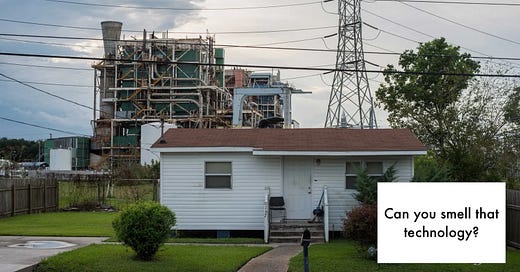The Slow Violence of Emerging Technologies [part one]
Understanding the long tail of harm that trails behind the technologies "we" develop
I have been thinking a lot of late about how we tell stories of harm in technology systems. Two concepts that have been framing my thinking are 'slow violence' and 'kind environments'. In this issue, I'll dive into slow violence.
Rob Nixon — in Slow Violence and the Environmentalism of the Poor — describes slow violence as a:
“a violence that occurs gradually, and out of sight, a violence of delayed destruction that is dispersed across time and space, an attritional violence that is typically not viewed as violence at all. Violence is customarily concerned as an event or action that is immediate in time, explosive and spectacular in space and as erupting into instant sensational visibility."
When we talk about socially beneficial technology, oftentimes we mean technology that does something useful. We talk collectively about that helpful function, long before we consider the ways in which it might manifest harm over time. I think in actuality, we see new technologies emerge that benefit some people, and often those people have power. For benefit to accrue, it has to smash through the world to reach a scale that can compound. And in that smashing, it causes harm that accrues. But the harm isn't accumulated by small groups the way the benefits are. Harm is diffuse, happening via many individual experiences and indignities. These harms are much more challenging to see (for those with power) than the benefits, until, all at once it becomes impossible to ignore.
This is a complex idea, and even a more complex process to change. The front end looks shiny and full of possibility. It attracts investment and excitement. The long tail of harm takes time to study, understand, and articulate. Slow violence provides a helpful frame to zoom out and see these systems from a better vantage point. As a concept it gives us new power to consider the stories of exciting innovation and of manifesting harms; in the frame of slow violence we can combine these stories into one about cause and effect. Where there is harm, there is a perpetrator. Where there is a perpetrator causing harm, there is violence. Where that harm is caused over time, accruing in ways we cannot predict, but nonetheless knowing that it will happen, there is slow violence.
Slow violence robs us of "sensational visibility", because the harm is physically, temporally, and geographically dislocated from the act that causes it. So, it becomes harder to see what is a key feature in violence: the perpetrator.
My main reflection of late is that while we individualise innovation as an outcropping of genius, we rarely revise our hero narratives when our heroes are (or become) villainous. We study harm in ways that are dislocated from the actions of perpetrators. We focus on intent.
Recently, the discourse in VAWG (violence against women and girls) has included calls for men to stop perpetrating violence, as opposed to focusing all problem solving attention on women and victims. My hope is that we will start to see a similar discourse shift in technology: that those who use communities of people as anvils for forging innovation are included in the narrative of harm in ways that allow more meaningful solutions to emerge.
To use Nixon's words, slow violence is "incremental, exponential, and far less sensationally visible" making it ever more important to develop societal narratives and perspective that allow us to eradicate it.
What might the future look like if we could orient technology production more systemically toward social benefit? What if we could zoom out, and build systems of justice and rehabilitation that address the slow violence of technology? That's where kind environments comes in, and I'll dig into it in the next issue.
If you want to get an issue of The Relay in your inbox every other Wednesday, subscribe. And, if you liked this one, check out the last issue here.
Something for people at foundations: if you've been enjoying The Relay, you may also find my handbook on How To Fund Tech useful. It brings together a decade of my experiences advising foundations and non-profits to use technology strategically and responsibly. You can get it here.




